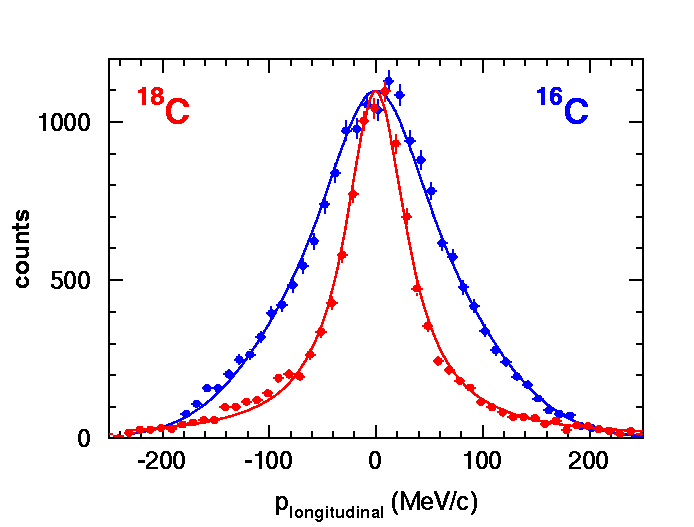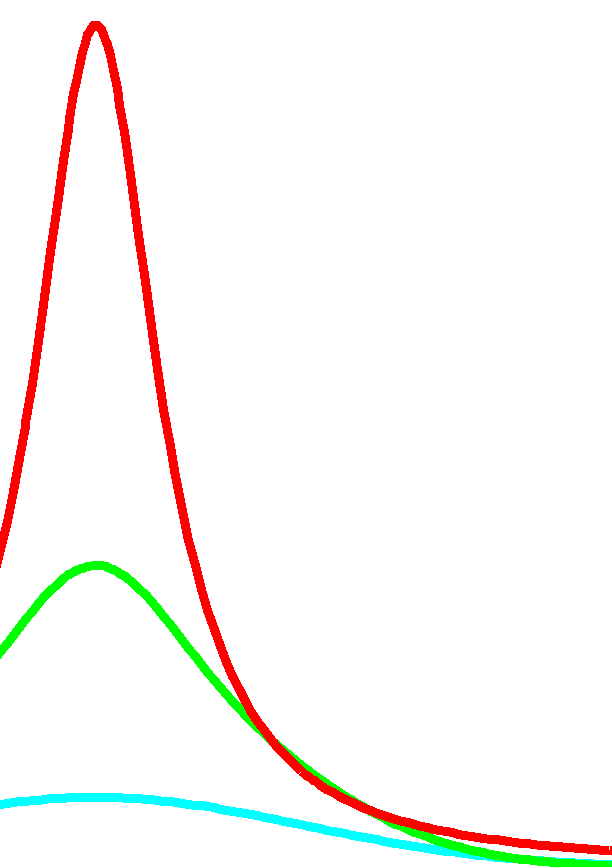Investigations of Halo Nuclei at the FRS
Abstract
The nuclei 8B and 19C were investigated in
breakup reactions at relativistic energies. The fragment separator
FRS at GSI was used
as an energy-loss spectrometer to measure the longitudinal momentum
distributions of the breakup fragments after one-nucleon removal.
Collaboration
T. Aumann, T. Baumann, L. Axelsson, U. Bergmann, M.J.G. Borge,
D. Cortina-Gil, L. Fraile, H. Geissel,
M. Hellström, M. Ivanov, N. Iwasa, R. Janik,
B. Jonson, H. Lenske, K. Markenroth,
G. Münzenberg, F. Nickel, T. Nilsson, A. Ozawa,
A. Richter, K. Riisager, C. Scheidenberger,
G. Schrieder, W. Schwab, H. Simon, B. Sitar,
M.H. Smedberg, P. Strmen, K. Sümmerer, T. Suzuki,
M. Winkler, and M.V. Zhukov
Nuclear halos are a well-established phenomenon for a few light nuclei
close to the neutron drip-line, with 11Be and
11Li being the classical cases. These nuclei are well-described
as two or three body systems, reflecting the halo structure in a
rather simple way. But there are cases where the label halo is not
so easily applied, among these are 8B, a nucleus at the proton
drip-line with the small binding energy of 137 keV, and 19C, the
last bound carbon isotope with odd neutron number. The question about
the existence of a proton halo in 8B and the difficulties to
describe the structure of 19C make these nuclei interesting
cases to study in detail.

Longitudinal momentum distribution of 16,18C fragments
after one-neutron removal from 17,19C, respectively.
The breakup reactions occured in a 4.4 g/cm2
C target at about 900 MeV/u.
The momentum distributions are transformed into the projectile frames and
the deduced FWHM are 69±3 MeV/c for 18C and
141±6 MeV/c for the 16C distribution.

|
Together with 19C and 17C, we also measured the
one-neutron removal from the stable nucleus 12C. Combining
information on the one-neutron removal cross sections and the
momentum distributions gives the nice picture displayed at the left, where
the red, green, and cyan curves correspond to the longitudinal momentum
distributions of 19C, 17C, and 12C,
respectively.
|
Contact person
For further questions, please contact
baumann@nscl.msu.edu.
Publications
-
Observation of a Proton Halo in 8B
W. Schwab, H. Geissel, H. Lenske, K.-H. Behr, A. Brünle,
K. Burkard, H. Irnich, T. Kobayashi, G. Kraus, A. Magel,
G. Münzenberg, F. Nickel, K. Riisager, C. Scheidenberger,
B.M. Sherrill, T. Suzuki, and B. Voss
Z. Phys. A350, 283 (1995)
-
Longitudinal momentum distributions of 16,18C
fragments after one-neutron removal from 17,19C
T. Baumann, H. Geissel, H. Lenske, K. Markenroth, W. Schwab, M.H. Smedberg,
T. Aumann, L. Axelsson, U. Bergmann, M.J.G. Borge, D. Cortina-Gil, L. Fraile,
M. Hellström, M. Ivanov, N. Iwasa, R. Janik, B. Jonson,
G. Münzenberg, F. Nickel, T. Nilsson, A. Ozawa, A. Richter,
K. Riisager, C. Scheidenberger, G. Schrieder, H. Simon, B. Sitar,
P. Strmen, K. Sümmerer, T. Suzuki, M. Winkler, H. Wollnik
and M.V. Zhukov
Phys. Lett. B, volume 439, issue 3-4, pages 256-261, November 1998
Get the article online from
Elsevier
or view the e-print
of this paper!


